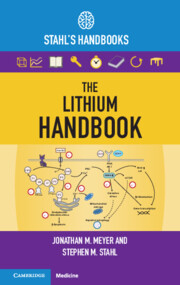Book contents
- The Lithium Handbook
- Reviews
- The Lithium Handbook
- Copyright page
- Contents
- Foreword
- Preface: How to Use This Handbook
- Introduction
- 1 The Efficacy Story
- 2 Renal Handling of Lithium
- 3 Clinical Pharmacokinetics
- 4 Lithium Initiation and Monitoring
- 5 Management of Routine Lithium Related Adverse Effects
- 6 Lithium Toxicity
- 7 Special Populations and Circumstances
- 8 Lithium Discontinuation
- Index
- References
3 - Clinical Pharmacokinetics
Principles Underlying Kinetic and Pharmacodynamic Drug Interactions; Clinically Relevant Drug Interactions and Their Management
Published online by Cambridge University Press: 09 February 2024
- The Lithium Handbook
- Reviews
- The Lithium Handbook
- Copyright page
- Contents
- Foreword
- Preface: How to Use This Handbook
- Introduction
- 1 The Efficacy Story
- 2 Renal Handling of Lithium
- 3 Clinical Pharmacokinetics
- 4 Lithium Initiation and Monitoring
- 5 Management of Routine Lithium Related Adverse Effects
- 6 Lithium Toxicity
- 7 Special Populations and Circumstances
- 8 Lithium Discontinuation
- Index
- References
Summary
As clinical psychopharmacology moves into the twenty-first century, there is an emphasis on rational prescribing practices informed by pharmacokinetic principles and clinical dictates. Publications note that certain oral medications which historically were dosed more than once per day (e.g. most antipsychotics including clozapine) have comparable efficacy with nightly (QHS) dosing for the majority of patients [1–3].
- Type
- Chapter
- Information
- The Lithium HandbookStahl's Handbooks, pp. 151 - 202Publisher: Cambridge University PressPrint publication year: 2023

